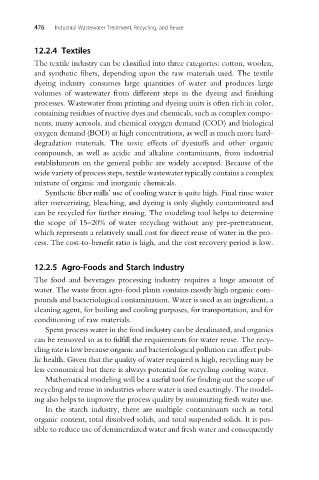Page 506 - Industrial Wastewater Treatment, Recycling and Reuse
P. 506
476 Industrial Wastewater Treatment, Recycling, and Reuse
12.2.4 Textiles
The textile industry can be classified into three categories: cotton, woolen,
and synthetic fibers, depending upon the raw materials used. The textile
dyeing industry consumes large quantities of water and produces large
volumes of wastewater from different steps in the dyeing and finishing
processes. Wastewater from printing and dyeing units is often rich in color,
containing residues of reactive dyes and chemicals, such as complex compo-
nents, many aerosols, and chemical oxygen demand (COD) and biological
oxygen demand (BOD) at high concentrations, as well as much more hard-
degradation materials. The toxic effects of dyestuffs and other organic
compounds, as well as acidic and alkaline contaminants, from industrial
establishments on the general public are widely accepted. Because of the
wide variety of process steps, textile wastewater typically contains a complex
mixture of organic and inorganic chemicals.
Synthetic fiber mills’ use of cooling water is quite high. Final rinse water
after mercerizing, bleaching, and dyeing is only slightly contaminated and
can be recycled for further rinsing. The modeling tool helps to determine
the scope of 15–20% of water recycling without any pre-pretreatment,
which represents a relatively small cost for direct reuse of water in the pro-
cess. The cost-to-benefit ratio is high, and the cost recovery period is low.
12.2.5 Agro-Foods and Starch Industry
The food and beverages processing industry requires a huge amount of
water. The waste from agro-food plants contains mostly high organic com-
pounds and bacteriological contamination. Water is used as an ingredient, a
cleaning agent, for boiling and cooling purposes, for transportation, and for
conditioning of raw materials.
Spent process water in the food industry can be desalinated, and organics
can be removed so as to fulfill the requirements for water reuse. The recy-
cling rate is low because organic and bacteriological pollution can affect pub-
lic health. Given that the quality of water required is high, recycling may be
less economical but there is always potential for recycling cooling water.
Mathematical modeling will be a useful tool for finding out the scope of
recycling and reuse in industries where water is used exactingly. The model-
ing also helps to improve the process quality by minimizing fresh water use.
In the starch industry, there are multiple contaminants such as total
organic content, total dissolved solids, and total suspended solids. It is pos-
sible to reduce use of demineralized water and fresh water and consequently

